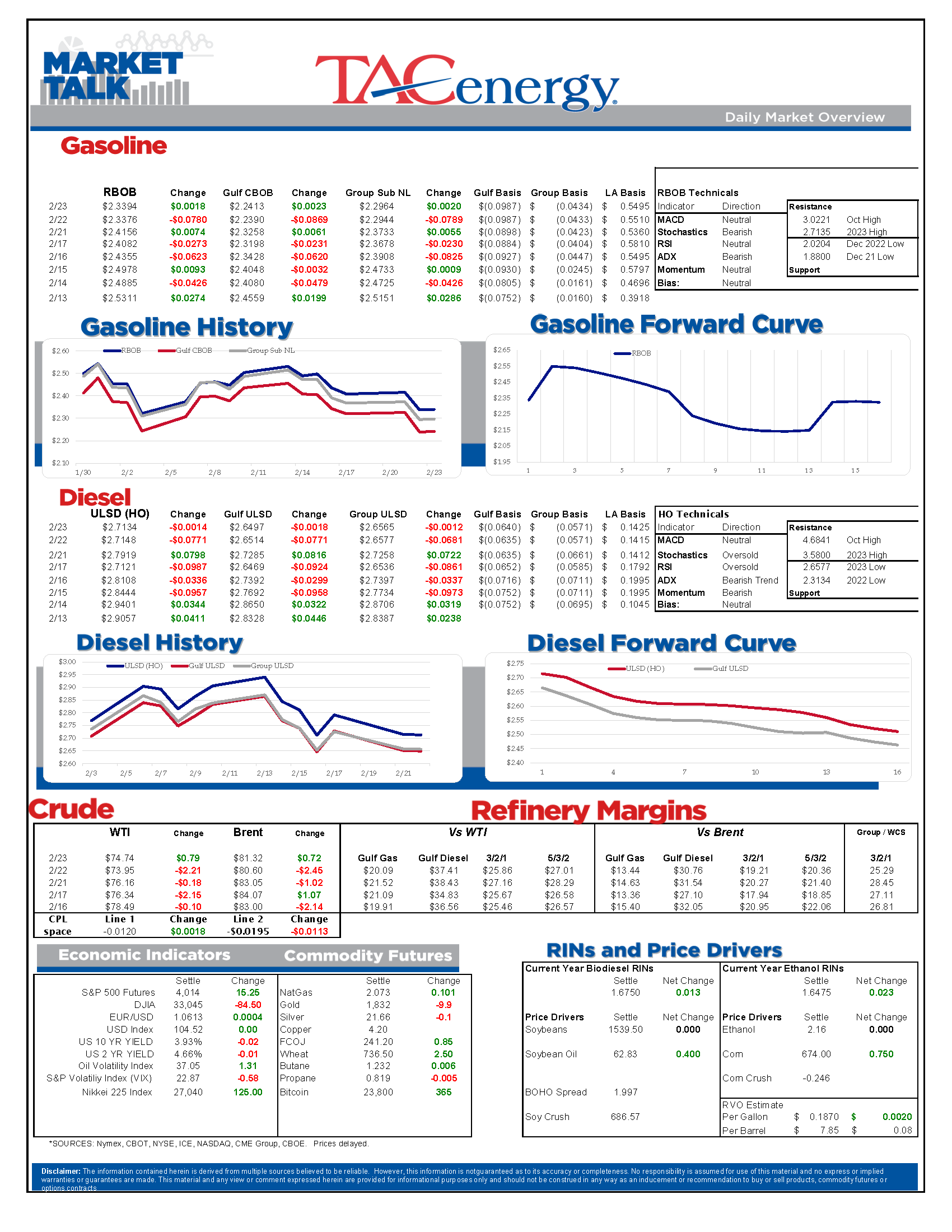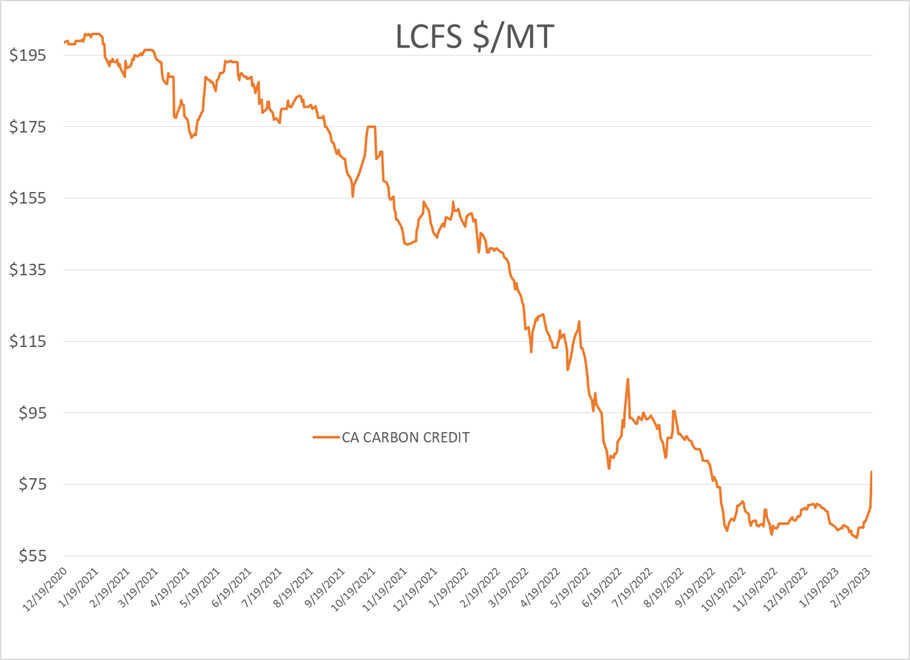ULSD Wiped Out The 8 Cent Gains From Tuesday

Energy contracts were trying to bounce to start Thursday’s session after another heavy wave of selling knocked them sharply lower on Wednesday and saw ULSD wipe out the 8 cent gains from Tuesday.
WTI has traded lower for 6 consecutive trading sessions, but still doesn’t look overly bearish on the charts, as it remains above the lows set in each of the prior 3 months. That said, the contract is “only” $5 away from setting new lows for the past year, and if the December support near $70 breaks, there’s not much on the charts to stop a slide to $62.
Russia is trying to stop the slide in oil prices, with reports suggesting plans to cut exports from Western ports by 25%, in excess of the already announced production cuts. The relative lack of reaction to that latest attempt to stir the oil pot is yet another sign of the weak market sentiment compared to a year ago when the war broke out.
ULSD still looks the most bearish on the charts, even though fundamentally there’s a strong argument that diesel stocks remain in the most precarious position. Even with today’s modest gains, ULSD prices are just 7 cents off of their lows for the past 12 months and if the $2.66 range fails to hold it looks like there’s a good chance, we’ll see a quick move towards $2.50.
The API reported another large build in US Crude stocks of nearly 10 million barrels last week, adding to last week’s estimate of a 10.5-million-barrel gain. The API’s figures seem to be catching up to the EIA’s data that showed stocks swelled by 16 million barrels last week as refiners cut runs due to heavy maintenance scheduled and numerous unplanned outages. The API also estimated small builds in gasoline and diesel inventories, in line with seasonal expectations. The EIA’s report is due out at 11am Eastern.
California’s LCFS credits spiked to a 6 month high this week after CARB suggested it would propose accelerating its emissions reduction targets this week to prop up prices that have come under steady selling pressure over the past 2 years thanks to a surge in renewables production. The $20 increase in credits this week adds roughly 2.5 cents/gallon to the cost of each gasoline and diesel (which create a deficit under the program) sold in the state but increases the value of Renewable Diesel by 10-13 cents/gallon depending on the CI value of the product.
California’s Cap and Trade program credits (CCAs) didn’t move on this news, as that program has a set credit amount, rather than a mechanism for renewable producers to create credits. The February CCA auction results are expected later this afternoon, which can be a market moving event depending on where prices settled out in the quarterly auction vs where they’ve been trading in the open market.
Click here to download a PDF of today's TACenergy Market Talk.
Latest Posts
Week 17 - US DOE Inventory Recap
The Energy Complex Is Trading Modestly Lower So Far This Morning With WTI Crude Oil Futures Leading The Way
Energy Futures Are Drifting Quietly Higher This Morning
Refined Products Holding Close To Break Even While Oil Prices Are Losing Just Under 1%
Social Media
News & Views
View All
Week 17 - US DOE Inventory Recap

The Energy Complex Is Trading Modestly Lower So Far This Morning With WTI Crude Oil Futures Leading The Way
The energy complex is trading modestly lower so far this morning with WTI crude oil futures leading the way, exchanging hands $1.50 per barrel lower (-1.9%) than Tuesday’s settlement price. Gasoline and diesel futures are following suit, dropping .0390 and .0280 per gallon, respectively.
A surprise crude oil build (one that doesn’t include any changes to the SPR) as reported by the American Petroleum Institute late Tuesday is taking credit for the bearish trading seen this morning. The Institute estimated an increase in crude inventories of ~5 million barrels and drop in both refined product stocks of 1.5-2.2 million barrels for the week ending April 26. The Department of Energy’s official report is due out at it’s regular time (9:30 CDT) this morning.
The Senate Budget Committee is scheduled to hold a hearing at 9:00 AM EST this morning regarding a years-long probe into climate change messaging from big oil companies. Following a 3-year investigation, Senate and House Democrats released their final report yesterday alleging major oil companies have internally recognized the impacts of fossil fuels on the climate since as far back as the 1960s, while privately lobbying against climate legislation and publicly presenting a narrative that undermines a connection between the two. Whether this will have a tangible effect on policy or is just the latest announcement in an election-yeardeluge is yet to be seen.
Speaking of deluge, another drone attack was launched against Russian infrastructure earlier this morning, causing an explosion and subsequent fire at Rosneft’s Ryazan refinery. While likely a response to the five killed from Russian missile strikes in Odesa and Kharkiv, Kyiv has yet to officially claim responsibility for the attack that successfully struck state infrastructure just 130 miles from Moscow.
The crude oil bears are on a tear this past week, blowing past WTI’s 5 and 10 day moving averages on Monday and opening below it’s 50-day MA this morning. The $80 level is likely a key resistance level, below which the path is open for the American oil benchmark to drop to the $75 level in short order.
Click here to download a PDF of today's TACenergy Market Talk.

Energy Futures Are Drifting Quietly Higher This Morning
Energy futures are drifting quietly higher this morning as a new round of hostage negotiations between Israel and Hamas seem to show relative promise. It seems the market is focusing on the prospect of cooler heads prevailing, rather than the pervasive rocket/drone exchanges, the latest of which took place over Israel’s northern border.
A warmer-than-expected winter depressed diesel demand and, likewise, distillate refinery margins, which has dropped to its lowest level since the beginning of 2022. The ULSD forward curve has shifted into contango (carry) over the past month as traders seek to store their diesel inventories and hope for a pickup in demand, domestic or otherwise.
The DOE announced it had continued rebuilding it’s Strategic Petroleum Reserve this month, noting the addition of 2.3 million barrels of crude so far in April. Depending on what the private sector reported for last week, Wednesday’s DOE report may put current national crude oil inventories (include those of the SPR) above the year’s previous levels, something we haven’t seen since April of 2022, two months after Ukraine war began.
The latest in the Dangote Refinery Saga: Credit stall-out, rising oil prices, and currency exchange.
Click here to download a PDF of today's TACenergy Market Talk.


